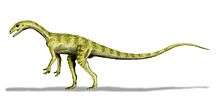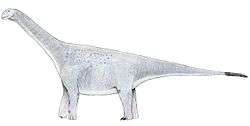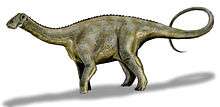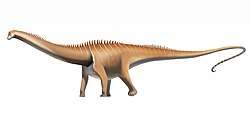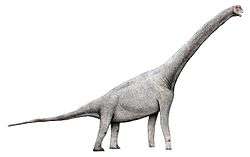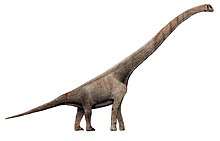Bellusaurus
Bellusaurus (meaning "Beautiful lizard", from Vulgar Latin bellus 'beautiful' (masculine form) and Ancient Greek sauros 'lizard') was a small short-necked sauropod dinosaur from the Middle Jurassic which measured about 4.8 metres (16 ft) long. Its fossils were found in Shishugou Formation rocks in the northeastern Junggar Basin in China.[1]
| Bellusaurus | |
|---|---|
 | |
| Restored skeleton | |
| Scientific classification | |
| Kingdom: | Animalia |
| Phylum: | Chordata |
| Clade: | Dinosauria |
| Clade: | Saurischia |
| Suborder: | †Sauropodomorpha |
| Clade: | †Sauropoda |
| Clade: | †Macronaria |
| Genus: | †Bellusaurus Dong, 1990 |
| Species: | †B. sui |
| Binomial name | |
| †Bellusaurus sui Dong, 1990 | |
Discovery and naming
The type and only known species is Bellusaurus sui, formally described by Dong Zhiming in 1990. The remains of Bellusaurus were found in the Shishugou Formation in the northeastern Junggar Basin in China. Seventeen individuals were found in a single quarry, suggesting that a herd had been killed in a flash flood. Some features suggest they may have all been juveniles.[2] Bellusaurus sui was derived from the Latin bellus meaning small, delicate, and beautiful, as these sauropods were small and lightly built. The specific name, sui, was named in honor of Senior Preparator Youling Sui, a notable restorer of dinosaurs remains. Bellusaurus was the last restoration undertaken by Mr. Sui.[2]
Description
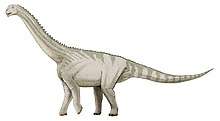

It is unknown if the material representing Bellusaurus is from juvenile specimens. Juvenile characteristics of dinosaurs have been noted by Galton in 1982 of stegosaur growth, whose study would suggest that the group of small Bellusaurus sauropods were juveniles that were subjected to a single catastrophe resulting in the mass death assemblage seen from this discovery.[3] Because of the uncertainty of the specimens age, it could be difficult to place the species into a specific taxonomic assignment due to having unstable morphological characteristics.[2]
References
- Dong Zhiming (1992). Dinosaurian Faunas of China. China Ocean Press, Beijing. ISBN 3-540-52084-8.
- Dong, Z. M. (1990). "On remains of the Sauropods from Kelamaili region, Junggar Basin, Xinjiang, China" (PDF). Vertebrata PalAsiatica. 28 (1): 43–58.
- Galton, P.M. (1982). "Juveniles of the stegosaurian dinosaur Stegosaurus from the Upper Jurassic of North America" (PDF). Jour. Vert. Paleo. (1 ed.) (2).

